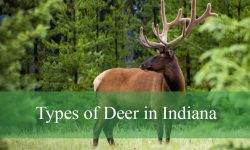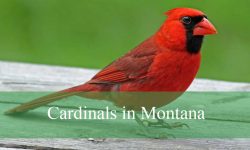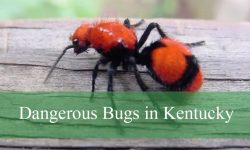Iowa, known for its rolling prairies and temperate woodlands, might not seem like a hotspot for reptile diversity, yet several fascinating lizard species thrive across the state. These reptiles are often elusive and well-camouflaged, living among rocks, grasslands, and forest edges. Despite the cold winters, certain species have adapted remarkably well to Iowa’s climate, remaining active during the warm months and hibernating underground during the harsh seasons.
In this guide, we will explore six types of lizards that call Iowa home. Each species has its own distinctive features, behaviors, and preferred habitats, making them an essential part of Iowa’s natural ecosystem.
Six-Lined Racerunner (Aspidoscelis sexlineata)
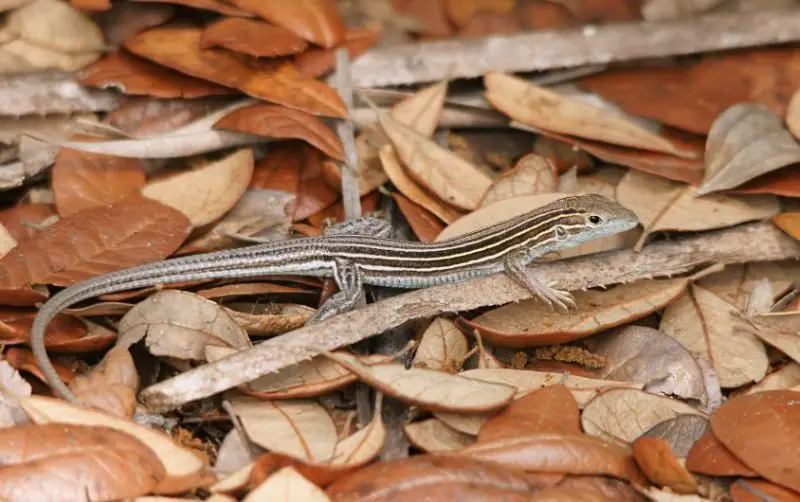
The Six-Lined Racerunner is one of the most active and visually striking lizards in Iowa. Its slender body and glossy dark coloration are accentuated by six vivid yellow or greenish-yellow stripes that run the full length of its back and tail. These distinctive markings make it instantly recognizable among the state’s reptile species. Adults typically measure between 6 and 10 inches long, with their tails often making up more than half of their total length.
This species is incredibly fast and agile, capable of sprinting swiftly across open terrain when startled or in pursuit of prey. Its name, “racerunner,” perfectly describes its behavior, as it rarely stays still for long. Observing one up close can be quite difficult due to its quick reflexes and tendency to dart into cover at the slightest movement. These bursts of speed help it evade predators such as birds and snakes.
Six-Lined Racerunners are primarily active during the hottest parts of the day, especially throughout the summer months. They are sun-loving reptiles that rely on warmth to maintain their high activity levels. You can often spot them racing across sandy paths, rocky slopes, or sunlit grasslands while hunting for insects, spiders, and other small invertebrates, which form the bulk of their diet.
In Iowa, they are most commonly found in the southern and southwestern regions, where the landscape provides the dry, open conditions they need. These areas typically feature sandy or rocky soils with limited vegetation, allowing the lizards to bask in full sunlight and dig easily into the ground for shelter. They often take refuge beneath rocks, logs, or leaf litter during the cooler parts of the day.
When winter approaches, Six-Lined Racerunners enter a state of brumation to survive the cold. They retreat underground, using their strong limbs and claws to dig deep burrows where temperatures remain more stable. This dormant period lasts until spring returns, when they emerge once again to bask, feed, and breed under Iowa’s warming sun.
Northern Prairie Skink (Plestiodon septentrionalis septentrionalis)
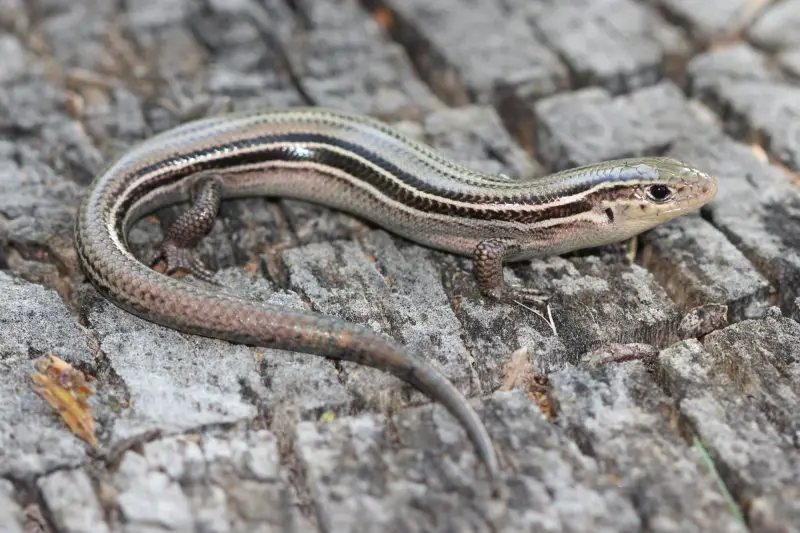
The Northern Prairie Skink is one of Iowa’s most adaptable and resilient lizard species, thriving across much of the state’s grasslands and prairies. It features a sleek, glossy body with brownish or olive tones and subtle, pale stripes running lengthwise along its sides. Adults typically range from 5 to 8 inches in total length, and during the breeding season, males develop bright orange patches on their heads and throats—an eye-catching feature used to attract mates.
This skink prefers open prairies, sandy hills, and loose, well-drained soils found throughout western and central Iowa. Its burrowing behavior allows it to escape harsh weather conditions and evade predators such as birds, snakes, and mammals. By creating intricate tunnels underground, it can regulate temperature and humidity while remaining hidden from threats. These burrows also serve as nesting sites and safe havens during extreme heat or drought.
Primarily insectivorous, the Northern Prairie Skink feeds on a variety of small invertebrates, including beetles, crickets, grasshoppers, and spiders. Its fast, darting movements make it an efficient hunter, able to capture prey both on the surface and within leaf litter. When threatened, this lizard employs a remarkable defense mechanism—tail autotomy. By detaching its tail, which continues to wiggle and distract predators, the skink gains valuable seconds to flee to safety.
During the warmer months, especially in spring and summer, Northern Prairie Skinks can be seen basking on sunny rocks, logs, or open soil patches to absorb heat. Like most reptiles, they rely on external warmth to maintain their energy and metabolic functions. Once warmed, they become highly active, foraging for food or searching for mates in their grassy habitats.
Reproduction typically occurs in late spring, with females laying small clutches of eggs in moist, sheltered underground nests. Some females remain near their eggs until hatching, providing limited parental protection. The combination of their wide habitat tolerance, effective defense strategies, and adaptability to Iowa’s variable climate makes the Northern Prairie Skink one of the most successful and enduring reptiles in the region.
Common Five-Lined Skink (Plestiodon fasciatus)
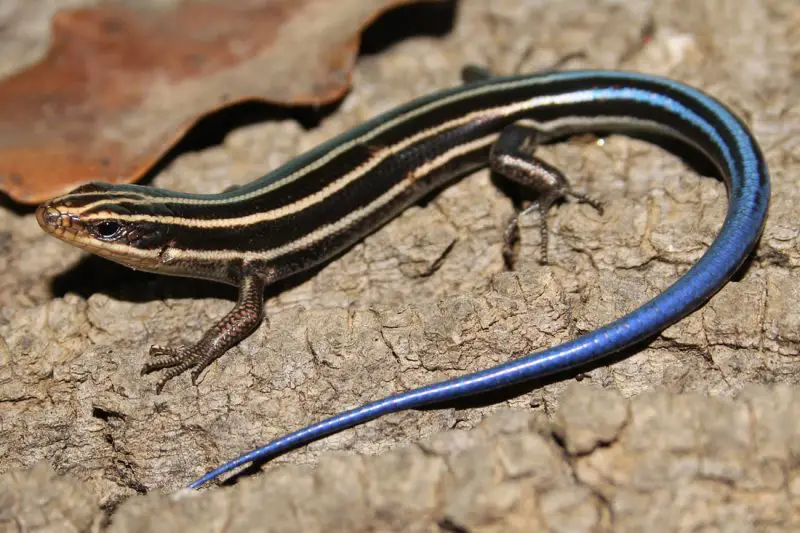
The Common Five-Lined Skink is one of Iowa’s most recognizable and widespread lizards, often found in forested and rocky environments. Its sleek body is marked by five distinct light-colored stripes running from head to tail across a dark brown or black background. Juveniles are especially eye-catching due to their brilliant blue tails, which serve to distract predators. As these skinks mature, their coloration gradually fades to more subdued shades of brown or gray. Adults usually grow between 5 and 8.5 inches long, featuring smooth, shiny scales that give them a polished appearance.
This species favors woodlands, rocky bluffs, and hillsides where fallen logs, decaying stumps, and rock piles provide ideal shelter. The Common Five-Lined Skink is a secretive reptile, spending much of its time hidden beneath debris or leaf litter. It becomes most active during warm, sunny days, when it emerges to bask and regulate its body temperature. This behavior is vital for maintaining the energy levels needed for hunting and reproduction.
Its diet consists primarily of small insects, spiders, beetles, and other invertebrates. With its quick reflexes and agile movements, the skink efficiently hunts down prey, helping maintain ecological balance by reducing pest populations. The species’ feeding habits make it an important natural ally in controlling insects within its native habitats.
In Iowa, the Common Five-Lined Skink is most frequently encountered in the southern and southeastern counties, where suitable woodland and rocky terrain are abundant. It prefers moist, shaded areas but can also adapt to drier slopes if sufficient cover is available. These adaptable lizards are often seen basking on rocks or tree trunks near forest edges during midday warmth.
During the breeding season, which occurs in late spring and early summer, males develop a bright orange coloration on their jaws—a visual cue used in courtship and territorial displays. Females lay clutches of eggs in damp, protected areas such as rotting logs or under stones. Remarkably, mothers guard their eggs until hatching, a rare behavior among reptiles that significantly increases the offspring’s chances of survival. This combination of adaptability, parental care, and striking appearance makes the Common Five-Lined Skink one of Iowa’s most fascinating native reptiles.
Great Plains Skink (Plestiodon obsoletus)
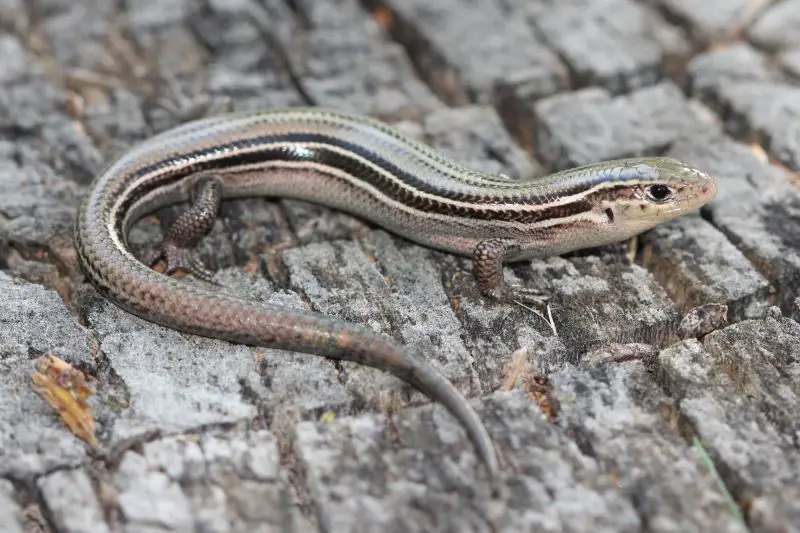
The Great Plains Skink stands out as the largest lizard species native to Iowa, capable of reaching an impressive length of up to 13 inches. Its sturdy body is covered with glossy, overlapping scales that display a beautiful mosaic of gray, tan, and brown tones. This coloration provides excellent camouflage against the dry, rocky, and grassy landscapes it inhabits, allowing the skink to remain nearly invisible to both predators and prey. Its thick tail and powerful limbs further enhance its ability to maneuver efficiently through rugged terrain.
This species thrives in dry, open habitats and is especially well-suited for life in arid environments. Unlike smaller or more delicate skinks, the Great Plains Skink is a strong digger, often creating elaborate burrow systems for shelter and protection from predators or extreme temperatures. In Iowa, it is found mainly in the southwestern region, where prairies merge with rocky bluffs and grasslands. These areas provide the ideal mix of warmth, loose soil, and hiding spots that the species needs to survive and reproduce.
Diet plays a vital role in the skink’s adaptability. The Great Plains Skink is primarily insectivorous, feeding on beetles, crickets, grasshoppers, and caterpillars. However, it is also known to consume small vertebrates such as young mice or smaller lizards when opportunities arise. Its hunting strategy relies on stealth and sudden bursts of speed, allowing it to ambush prey with precision. This diverse diet supports its larger body size and high energy demands, especially during the breeding season.
The breeding season begins in spring, following the skink’s emergence from winter dormancy. Females excavate burrows or use existing tunnels to lay their clutches of eggs in concealed, humid chambers that protect them from desiccation and predators. After about two months, the young hatch in mid to late summer. Juvenile skinks resemble the adults in form but have darker, more vivid coloration, which gradually fades as they mature. The mothers sometimes remain near the nesting site, providing limited protection until the hatchlings disperse.
Despite its strength and adaptability, the Great Plains Skink remains relatively uncommon in Iowa due to its limited range and the gradual loss of suitable prairie and rocky habitats. Agricultural expansion, habitat fragmentation, and reduced native grasslands have all contributed to its scarcity. Nevertheless, its impressive size, resilience, and striking appearance make it one of Iowa’s most fascinating reptiles—a true survivor of the Great Plains ecosystem.
Slender Glass Lizard (Ophisaurus attenuatus)
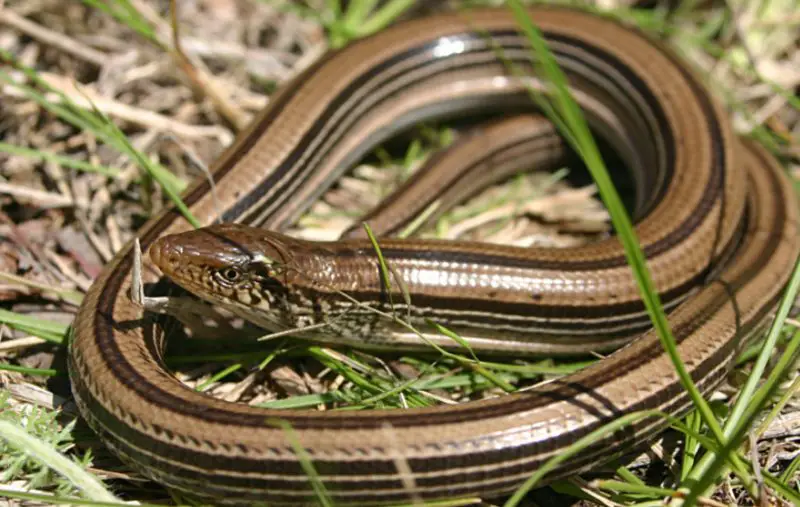
The Slender Glass Lizard is one of Iowa’s most unusual and misunderstood reptiles, often mistaken for a snake due to its long, legless body. Despite this resemblance, it is a true lizard, belonging to a unique group known for their elongated, fragile tails. Adults can reach impressive lengths of up to 36 inches, but nearly two-thirds of that length is composed of the tail. The species earns the name “glass lizard” because its tail can easily break off when grabbed by a predator, allowing the lizard to escape while the detached tail wriggles distractingly on the ground.
A closer look reveals several traits that distinguish the Slender Glass Lizard from snakes. Unlike snakes, it has movable eyelids and visible external ear openings—clear signs of its lizard lineage. Its scales are smooth and glossy, giving it a sleek appearance that glistens in the sunlight. The coloration typically ranges from tan to light brown, sometimes marked with faint dark stripes along the body, which help it blend seamlessly with grasslands and sandy environments.
This elusive species prefers open habitats such as prairies, sandhills, and grassy field edges where it can burrow easily or hide beneath logs, rocks, and leaf litter. It relies heavily on concealment and agility for survival. The Slender Glass Lizard’s diet consists primarily of insects, spiders, and other invertebrates, though it will also consume small vertebrates like young rodents, small snakes, or other lizards when available. Its hunting style involves quick lunges and strong jaw grips rather than pursuit, a strategy suited to its limited mobility without limbs.
In Iowa, the Slender Glass Lizard is considered rare, with most confirmed sightings coming from the southern part of the state. It favors warm, dry areas with loose soil that supports burrowing and thermoregulation. The lizard is most active between May and September, basking during sunny mornings and retreating underground during the heat of the day. Because of its reclusive habits and tendency to remain hidden, it is seldom seen even where populations persist.
To survive the colder months, Slender Glass Lizards enter a period of brumation, retreating deep underground or into rodent burrows to escape freezing temperatures. Habitat loss, agricultural development, and fragmentation of native prairies have further reduced their range in Iowa. Despite their rarity, these legless lizards play an important ecological role as both predator and prey, helping control insect populations and contributing to the biodiversity of Iowa’s grassland ecosystems.
Coal Skink (Plestiodon anthracinus)
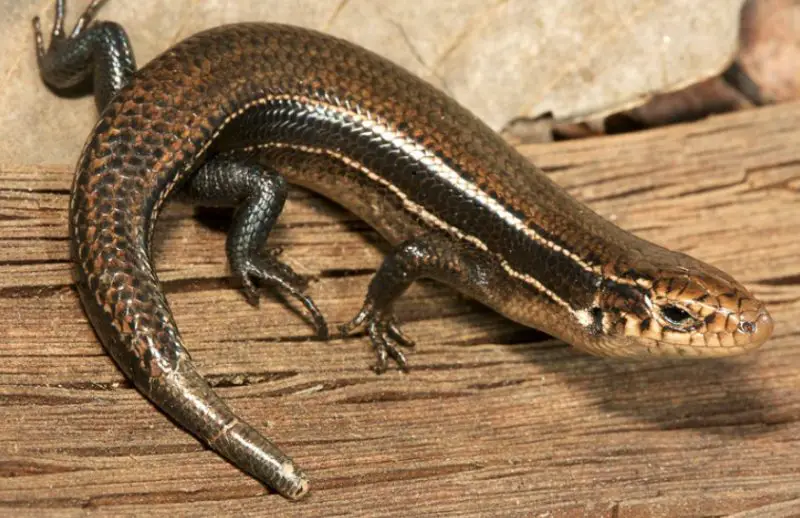
The Coal Skink is among Iowa’s most secretive and least commonly observed lizard species, known for its shy behavior and preference for secluded habitats. It is a small, smooth-scaled reptile, usually measuring between 5 and 7 inches in total length. Its dark brown or nearly black body is accented by two narrow, light-colored stripes running along the sides from head to mid-body, where they abruptly end—one of its most distinctive identifying traits. The contrast between the dark body and light stripes gives the Coal Skink a sleek, understated appearance perfectly suited to its shadowy woodland home.
This skink thrives in moist, forested environments where cover and humidity are abundant. It favors wooded slopes, shaded hillsides, and streamside habitats, particularly areas with thick leaf litter, loose soil, or decaying logs. These microhabitats not only provide shelter from predators but also help the skink maintain its preferred moisture levels. Coal Skinks are quick and elusive, often vanishing beneath debris or into burrows when disturbed. Their ability to move rapidly and blend into their surroundings makes them difficult to locate, even for experienced naturalists.
Feeding primarily on small insects and other invertebrates, the Coal Skink plays an important role in maintaining ecological balance within its habitat. Its diet includes ants, beetles, spiders, and crickets, all of which it hunts using swift, darting movements. Like many skinks, it may use its tail as a decoy when threatened—detaching it to distract predators while making a quick escape. The tail later regenerates, though usually in a slightly duller color than the original.
In Iowa, Coal Skinks are found mainly in the southern and eastern portions of the state, where woodland habitats remain relatively intact. Their presence is closely tied to areas with permanent or seasonal streams, as the humidity in these regions is vital for their survival. The species is most active from spring through early autumn, spending cooler months buried underground in a state of brumation to withstand Iowa’s freezing winters.
Breeding occurs in spring, and females lay small clutches of eggs in concealed nests beneath leaf litter or within soft, damp soil. The eggs hatch in mid to late summer, producing miniature versions of the adults that quickly learn to fend for themselves. Although rarely seen, the Coal Skink serves as an important indicator of healthy forest ecosystems in Iowa. Its dependence on clean, moist environments makes its presence a sign of good habitat quality and balanced woodland ecology.
Identifying Lizards in Iowa
Identifying Iowa’s lizards can be challenging, especially since several species are elusive and well-camouflaged. The easiest way to tell them apart is by observing body shape, size, coloration, and habitat. Skinks generally have smooth, shiny scales and well-developed legs, while glass lizards lack limbs entirely but retain eyelids and ear openings. Racerunners stand out for their speed and bold stripes.
During summer, these reptiles are most active during mid-morning and late afternoon, basking on sun-warmed surfaces before retreating to cooler shelters. Because of their shy nature, approaching them quietly and maintaining a distance increases the chance of observation without disturbance.
Where to See Lizards in Iowa
The best places to find lizards in Iowa include sunny prairies, rocky hillsides, and sandy grasslands, particularly in the southern and western parts of the state. State parks and natural preserves like Waubonsie State Park and Ledges State Park often provide suitable habitats for species such as the Northern Prairie Skink and Six-Lined Racerunner.
Spring through late summer is the optimal time for lizard watching, as these reptiles are most active during warm, dry weather. Early morning hours offer good visibility when lizards bask to absorb heat. Observing them responsibly helps conserve their populations, especially as habitat loss and human activity continue to pose challenges.
Conservation and Ecological Importance
Although Iowa’s lizard diversity is modest, these reptiles play crucial roles in maintaining ecological balance. By preying on insects and small invertebrates, lizards help regulate pest populations naturally. Their presence also supports higher predators, including snakes and birds, forming an integral part of the food web.
Habitat destruction, agricultural expansion, and urban development threaten several lizard species in Iowa. Preserving prairie remnants, forest edges, and rocky habitats is essential to ensure their continued survival. Conservation programs focusing on habitat restoration and public awareness are vital for protecting these fascinating yet overlooked creatures.
Conclusion
The lizards of Iowa may not be as numerous as those in warmer states, but each species is an important piece of the state’s natural heritage. From the swift Six-Lined Racerunner to the elusive Slender Glass Lizard, these reptiles demonstrate incredible adaptability and resilience in an environment not always favorable to cold-blooded life.
Exploring Iowa’s natural areas with patience and curiosity offers a rewarding glimpse into this hidden world of reptiles. By understanding, appreciating, and protecting these remarkable species, we help preserve the delicate balance of Iowa’s ecosystems for future generations.
FAQs About Lizards in Iowa
Are there lizards in Iowa?
Yes, several lizard species live in Iowa. Although the state’s cool climate limits reptile diversity, you can still find species such as the Six-Lined Racerunner, Northern Prairie Skink, and Common Five-Lined Skink. These lizards are well-adapted to Iowa’s prairies, grasslands, and rocky habitats, remaining active in the warmer months before hibernating underground during winter.
What is the most common lizard in Iowa?
The Northern Prairie Skink is considered the most common lizard in Iowa. It thrives in sandy prairies and open fields across the western and central regions of the state. Its shiny scales and quick movements make it easily recognizable, and it often appears during sunny days when basking on rocks or logs.
Are lizards in Iowa dangerous to humans?
No, Iowa’s native lizards are completely harmless to humans. They are shy, non-venomous creatures that prefer to flee rather than fight. Most of them feed on insects and small invertebrates, helping control pest populations naturally. Even the larger species, such as the Great Plains Skink, pose no threat to people or pets.
Where can I find lizards in Iowa?
Lizards in Iowa are most often found in sunny, open environments such as prairies, rocky hillsides, and sandy grasslands. State parks like Waubonsie State Park and Ledges State Park are great locations for observing species like the Six-Lined Racerunner and Northern Prairie Skink. Look for them basking on rocks, logs, or near open trails during warm, dry days.
When is the best time to see lizards in Iowa?
The best time to observe lizards in Iowa is from late spring through early fall, typically from May to September. They are most active during warm mornings and late afternoons when temperatures are ideal for basking. During the cold winter months, lizards enter a state of dormancy called brumation and remain hidden underground until temperatures rise again.
How can I tell the difference between a lizard and a snake in Iowa?
While some Iowa lizards, such as the Slender Glass Lizard, resemble snakes because they lack legs, there are clear differences. Lizards have movable eyelids and visible ear openings, features that snakes do not possess. Additionally, glass lizards have more rigid bodies and can break off their tails as a defense mechanism, a trait not found in snakes.
Are any lizards in Iowa endangered?
Some lizards in Iowa, such as the Slender Glass Lizard and the Coal Skink, are considered rare due to habitat loss and limited distribution. Their populations have declined in recent decades as natural grasslands and wooded areas have been replaced by agriculture and development. Conservation efforts focusing on habitat preservation are crucial to protect these species.
Do lizards survive Iowa winters?
Yes, Iowa’s lizards survive the cold winters through a process called brumation. Instead of remaining active, they retreat underground into burrows or under rocks to escape freezing temperatures. During this time, their metabolism slows down significantly, allowing them to conserve energy until spring returns.
What do lizards eat in Iowa?
Iowa’s lizards are primarily insectivores, feeding on a variety of insects such as crickets, beetles, ants, and grasshoppers. Some larger species, like the Great Plains Skink, may also consume small vertebrates, including other lizards. Their diet helps maintain ecological balance by naturally reducing insect populations.
Can I keep an Iowa lizard as a pet?
While some species might seem suitable for captivity, collecting wild lizards in Iowa is strongly discouraged and may be regulated by state laws. Wild reptiles play vital roles in local ecosystems and often do not adapt well to captivity. It’s best to observe them in their natural habitats or choose captive-bred lizards from reputable breeders if you want a pet reptile.

